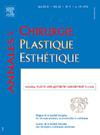Reconstruction mammaire différée par lambeau DIEP sans palette cutanée : technique et évaluation
IF 0.5
4区 医学
Q4 SURGERY
引用次数: 0
Abstract
Introduction
Le lambeau perforant épigastrique inférieur profond (DIEP) s’est imposé comme l’un des gold standards en reconstruction mammaire différée (RMD). Bien que la reconstruction avec palette cutanée soit couramment utilisée pour restaurer simultanément le volume et l’enveloppe cutanée, cette approche présente l’inconvénient esthétique d’un effet « patch ». Nous proposons une stratégie en trois étapes pour éviter cet effet : une RMD initiale par prothèse associée à un lambeau d’avancement abdominal et une symétrisation mammaire controlatérale, suivie d’une conversion par DIEP enfoui et un temps de retouches. Notre étude vise à étudier la faisabilité et l’efficacité de cette technique.
Matériel et méthodes
Une étude descriptive, monocentrique et rétrospective a été réalisée chez des patientes inclues de juillet 2019 à décembre 2023. Les complications et leur prise en charge ont été notées pour chaque étape.
Résultats
Quatre-vingt-deux procédures ont été initiées. Lors de la première étape, seize patientes (19,5 %) ont présenté une complication assimilable à un rejet de prothèse (inflammation cutanée ou sérome) nécessitant le plus souvent une prise en charge chirurgicale associée à une antibiothérapie. Soixante-douze patientes (87,8 %) ont bénéficié d’un DIEP avec enfouissement total, la moyenne de retouches par patiente était de 1,39. Cinq patientes (6,09 %) étaient satisfaites de leur reconstruction prothétique sans conversion.
Conclusion
La stratégie de RMD par DIEP avec enfouissement total est une alternative fiable et esthétique à la reconstruction avec palette cutanée. Cette étude montre la sécurité et la reproductibilité de cette technique avec une gestion efficace des complications.
Introduction
The deep inferior epigastric perforator (DIEP) flap has emerged as a gold standard in delayed breast reconstruction (DBR). Although the skin paddle technique is often employed to restore both volume and the skin envelope simultaneously. This procedure presents an aesthetic drawback, commonly referred to as a “patch” effect. We propose a three-stage approach to avoid this issue: initial reconstruction with a prosthesis combined with an abdominal advancement flap and contralateral breast symmetrization, followed by conversion to a buried DIEP flap with an option for further refinement. The objective of our study is to evaluate the security et efficiency of this method.
Material and methods
A monocentric, and retrospective study was conducted, encompassing patients who began this protocol between July 2019 and December 2023. Complications and their management were documented at each stage.
Results
A total of eighty-two procedures were initiated. In the first stage, sixteen patients (19.5%) experienced complications resembling prosthesis rejection, such as skin inflammation or seroma, most of which required surgical intervention coupled with antibiotic therapy. Seventy-two patients (87.8%) proceeded to DIEP flap reconstruction with complete burial of the flap, with an average of 1.39 touch-ups per patient. Five patients (6.09%) were satisfied with their prosthetic reconstruction and opted not to convert.
Conclusion
The strategy of DBR using a DIEP flap with complete burial, offers a reliable and aesthetically alternative to skin paddle reconstruction. This study underscores the safety and reproducibility of the technique, along with effective management of complications.
无皮瓣DIEP皮瓣延迟乳房再造术:技术、评价与处理。
简介:腹下深穿支皮瓣(DIEP)已成为延迟乳房重建(DBR)的金标准。虽然皮肤划桨技术经常被用来同时恢复体积和皮肤包膜。这种方法在美观上有缺点,通常被称为“贴片”效果。为了避免这个问题,我们提出了三个阶段的方法:首先用假体重建,结合腹部推进皮瓣和对侧乳房对称,然后转换为埋藏的DIEP皮瓣,并可选择进一步改进。我们研究的目的是评估这种方法的安全性和效率。材料和方法:进行了一项单中心回顾性研究,纳入了2019年7月至2023年12月期间开始该方案的患者。在每个阶段记录并发症及其处理。结果:共进行了82例手术。在第一阶段,16例患者(19.5%)出现了类似假体排斥反应的并发症,如皮肤炎症或血清肿,其中大多数需要手术干预和抗生素治疗。72例(87.8%)患者进行了DIEP皮瓣重建,皮瓣完全埋藏,平均每位患者1.39次修补。5例患者(6.09%)对义肢重建满意,选择不转行。结论:采用完全埋藏的DIEP皮瓣进行DBR是一种可靠且美观的皮肤瓣重建方法。这项研究强调了该技术的安全性和可重复性,以及对并发症的有效管理。
本文章由计算机程序翻译,如有差异,请以英文原文为准。
求助全文
约1分钟内获得全文
求助全文
来源期刊
CiteScore
1.00
自引率
0.00%
发文量
86
审稿时长
44 days
期刊介绍:
Qu''elle soit réparatrice après un traumatisme, pratiquée à la suite d''une malformation ou motivée par la gêne psychologique dans la vie du patient, la chirurgie plastique et esthétique touche toutes les parties du corps humain et concerne une large communauté de chirurgiens spécialisés.
Organe de la Société française de chirurgie plastique reconstructrice et esthétique, la revue publie 6 fois par an des éditoriaux, des mémoires originaux, des notes techniques, des faits cliniques, des actualités chirurgicales, des revues générales, des notes brèves, des lettres à la rédaction.
Sont également présentés des analyses d''articles et d''ouvrages, des comptes rendus de colloques, des informations professionnelles et un agenda des manifestations de la spécialité.

 求助内容:
求助内容: 应助结果提醒方式:
应助结果提醒方式:


